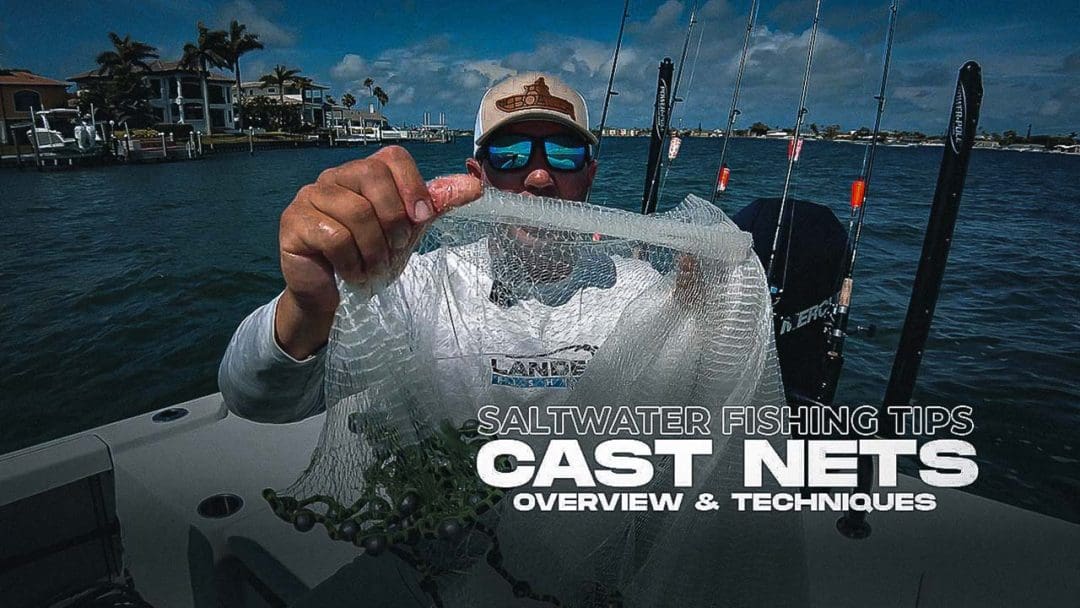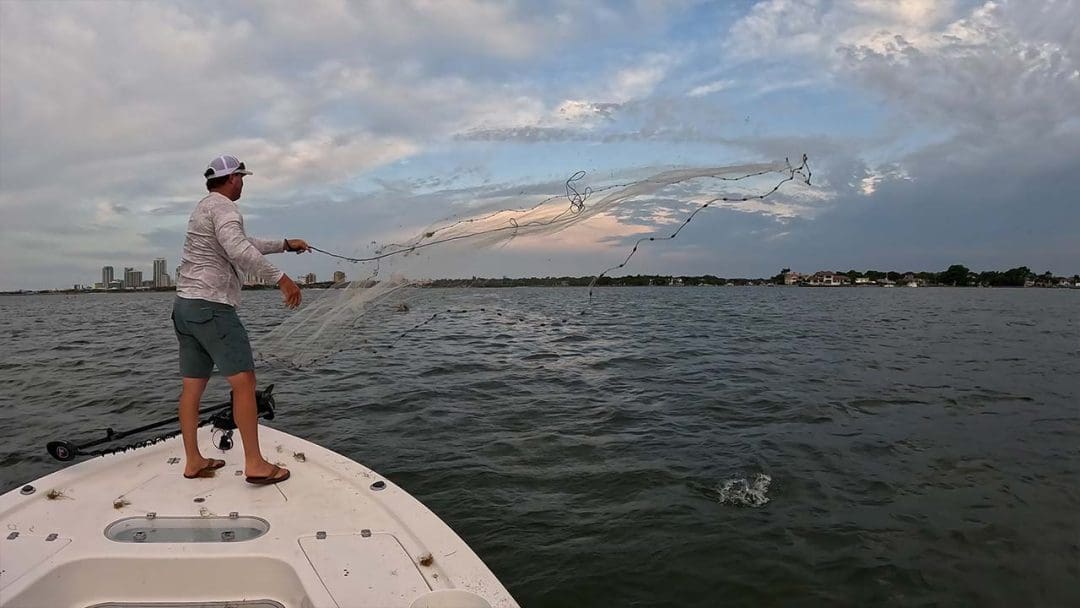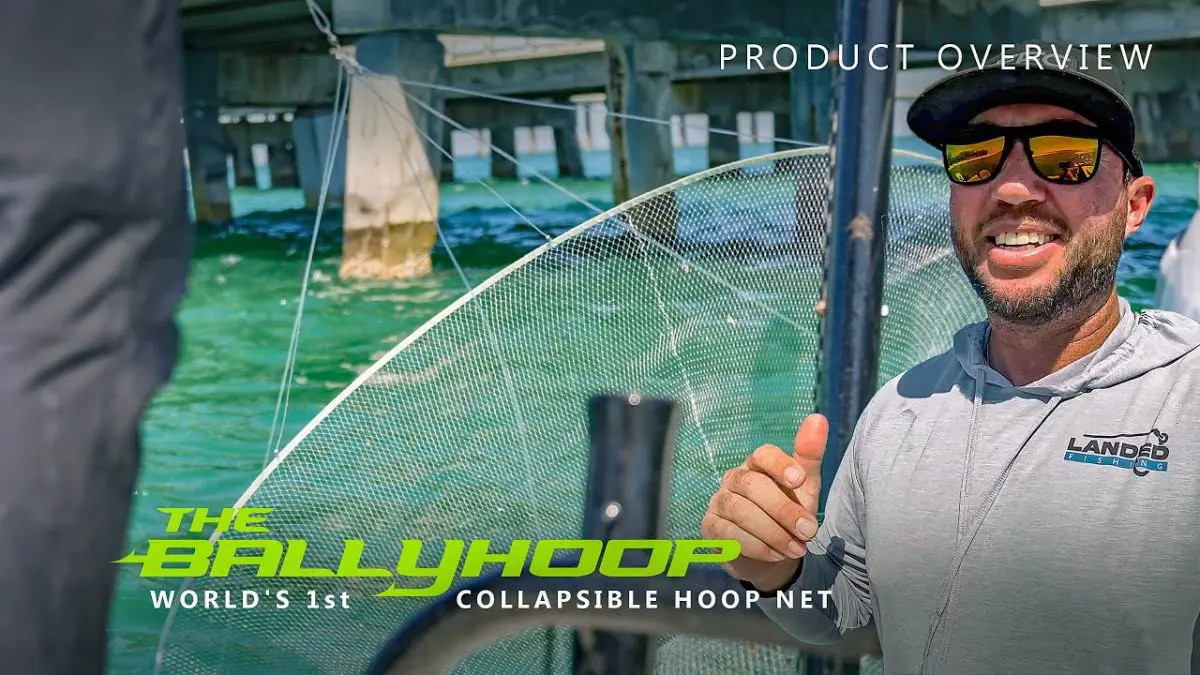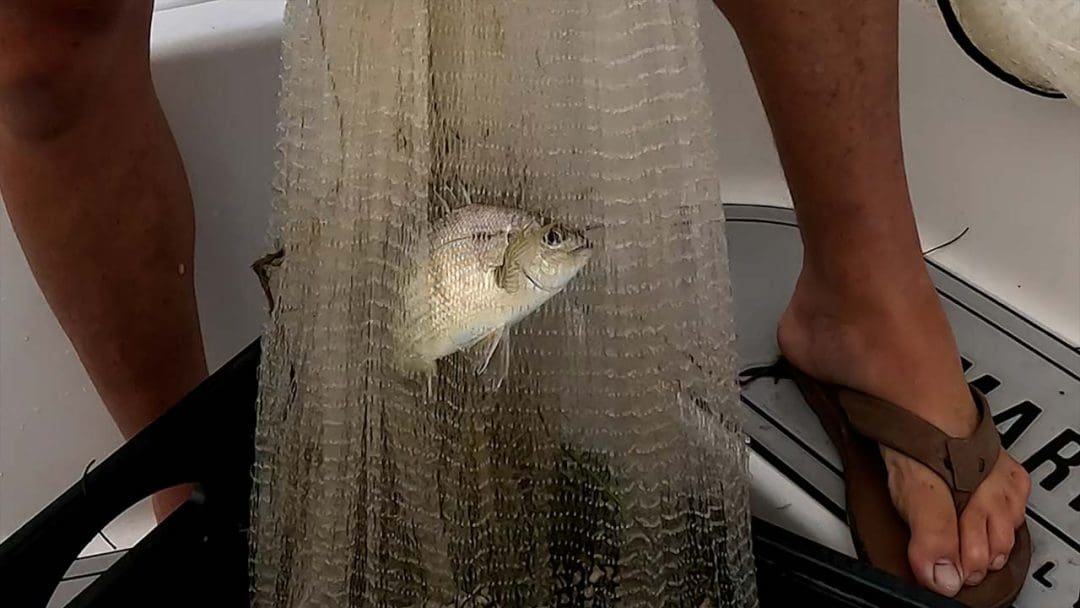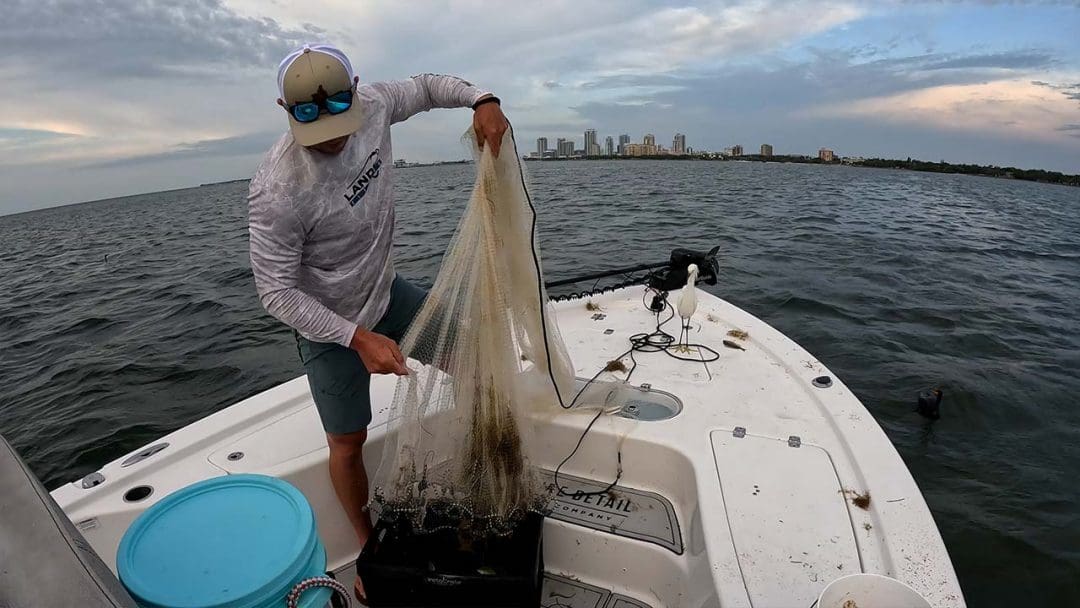What is a cast net?
Cast nets are valuable tools widely used in saltwater fishing to efficiently catch baitfish and shrimp. These nets are designed to be thrown or cast over a targeted area, allowing the fisherman to capture a large number of fish in a single throw.
Watch Video: How to Catch Bait with a Cast Net
How do I use a cast net?
The proper use of cast nets is often an important part for successful saltwater fishing, as it enables anglers to obtain live bait that can attract larger game fish.
Let’s explore the basics of cast nets and their use in the preparation of saltwater fishing, providing an overview of their importance and techniques for effective deployment.
Cast Net Alternative The BallyHoop Net
The BallyHoop nets offer innovative solutions as well as an alternative to traditional cast nets for anglers seeking efficient live bait capture.
Catching Bait for Saltwater Fishing
Using cast nets for baitfish can greatly improve your chances of a successful catch. Baitfish such as mullet, pilchards, or pinfish are highly sought after by predatory species like redfish, snook, trout and many other saltwater fish.
• Cast nets allow anglers to quickly and efficiently gather live bait, which can be used to attract larger game fish.
• When using a cast net for baitfish , it’s important to select a net with the appropriate size and mesh to capture the desired bait species.
• Throwing the net accurately and effectively is vital, as it allows you to target schools of baitfish and maximize your catch.
• Utilizing cast nets for baitfish provides an excellent opportunity for inshore anglers to entice and catch a wide range of game fish in their local waters.
Cast Nets: “Match the Hatch”
“Matching the Hatch” is a fundamental concept in fishing that involves aligning your bait selection with the target fish species’ natural prey.
By understanding the local waters and the specific food sources available to the fish you’re targeting, you can increase your chances of success.
What Size Cast Net Do I Need?
Here’s a guided overview on how to match the hatch and align your bait with the target fish species:
| Bait Type | Cast Net Size (Radius) | Mesh Size | Recommended Net Material |
|---|---|---|---|
| Shrimp | 4-8 feet (1.2-1.8 m) | 1/4 inch (0.6 cm) | Nylon or Monofilament |
| Small Fish | 6-12 feet (1.8-2.4 m) | 3/8 inch (0.9 cm) | Nylon or Monofilament |
| Medium-Sized Bait | 8-12 feet (2.4-3 m) | 1/2 inch (1.3 cm) | Nylon or Monofilament |
| Larger Bait | 10-12 feet (3-3.7 m) | 5/8 inch (1.6 cm) | Nylon or Monofilament |
Research the Target Species:
Begin by researching the feeding habits and preferred prey of the fish species you intend to catch. This information can be found in fishing guides, online resources, or by talking to local anglers or bait shops.
Gain local knowledge by asking around, checking local fishing reports to get an idea of what bait fish are best for your intended species.
Observe the Environment:
Take the time to observe the water body you’ll be fishing in. Look for signs of natural food sources such as insects, baitfish, or crustaceans.
Pay attention to the size, color, and movement patterns of these organisms, as they serve as valuable cues for selecting the right bait.
Choose Bait Type:
Once you have an understanding of the target species’ natural prey, select a bait type that closely resembles their favored food. This could include live bait, such as minnows, shrimp, or worms, or artificial lures designed to imitate specific prey items.
Consider factors like size, color, and action of the bait to mimic the natural forage effectively.
Match Bait Size:
It’s often important to match the size of your bait to the size of the natural prey the fish are targeting. If small baitfish or insects are prevalent, opt for smaller bait presentations. Conversely, if larger prey items are common, use larger-sized bait.
Matching the size helps to present bait that the fish are more likely to bite.
Experiment and Adapt:
While matching the hatch provides a good starting point, fishing conditions can vary, and fish behavior may change.
Be willing to experiment with different bait options and techniques. If you’re not getting bites, try adjusting the size, color, or presentation of your bait until you find what works best.
Cast Nets Sizes & Target Bait
Cast net hole sizes play a crucial role in capturing the intended bait during saltwater fishing. Smaller hole sizes like 1/4 inch or 3/8 inch are suitable for tiny baitfish or small shrimp, while larger hole sizes such as 3/4 inch or 1 inch are better for larger baitfish or crabs.
Selecting the right hole size ensures effective capture while allowing unwanted fish to escape, optimizing the cast net’s performance and minimizing harm to non-targeted marine life.
| Cast Net Hole Size | Type of Bait Intended |
|---|---|
| 1/4 inch (0.6 cm) | Tiny baitfish, small shrimp |
| 3/8 inch (0.9 cm) | Small to medium-sized shrimp |
| 1/2 inch (1.3 cm) | Medium-sized baitfish |
| 5/8 inch (1.6 cm) | Medium to large-sized shrimp |
| 3/4 inch (1.9 cm) | Large baitfish, larger shrimp |
| 1 inch (2.5 cm) | Large baitfish, crabs |
Chum Slicks & Cast Nets
Creating a chum slick is an effective technique to attract fish to the area where you’ll be casting your net. To create a chum slick for cast nets, start by selecting suitable chum, such as fish parts, shrimp, or squid.
Break the chum into small pieces or chunks, and mix it with water or a liquid fish attractant to create a soupy consistency.
Begin dispersing the chum mixture into the water, either by hand or using a chum bag or container with small holes. The chum should be released gradually and at regular intervals to create a consistent attractant trail.
This chum slick will draw fish towards the area where you’ll be casting your net, improving the chances of a successful catch by enticing the fish to feed and increasing their presence in the targeted zone.
Cast Nets & Chumming for Bait
Chumming is a widely used technique in saltwater fishing that involves attracting fish to a specific area by dispersing a mixture of bait and fish food into the water. When using a cast net for saltwater fishing, chumming can significantly enhance your chances of a successful catch. Here’s a brief overview of chumming techniques that can be employed in conjunction with a cast net:
Selecting the Right Chum:
Choose a chum that is suitable for the species of fish you are targeting. Common chum options include fish parts, shrimp, squid, or commercially available fish attractants. The chum should have a strong scent and be easily dispersible in the water.
Preparing the Chum:
Break the chum into small pieces or chunks and mix into paste with water. You can mix the chum with water or a liquid fish attractant to create better consistency, making it easier to distribute evenly.
Timing and Frequency:
Start chumming before casting your net to allow the scent and particles to disperse in the water. The frequency of chumming depends on the fishing conditions, but it is generally recommended to chum every few minutes to maintain a consistent attractant trail.
Casting and Net Placement:
Cast your net slightly up current from the chumming area to allow the net to drift through the chummed waters. Aim to position the net where the fish are actively feeding, typically near the surface or in areas with visible fish activity.
Retrieving the Net:
After casting the net, allow it to sink for a few seconds to ensure it captures fish in its radius. Then, retrieve the net by pulling it in slowly and steadily, keeping it under control to avoid tangling. The chumming should attract fish to the area, increasing the chances of a successful catch.
Adjusting Chumming Strategy:
Pay attention to the fish’s response to chumming. If they are actively feeding and following the chum trail, continue with the same technique. However, if the fish seem disinterested or not biting, you may need to adjust the amount, frequency, or type of chum used.
Remember to check local fishing regulations regarding chumming, as some areas may have restrictions or guidelines.
EXPLORE LANDED FISHING

Tampa Florida's Skyway Bridge Fishing Pier Join us as we team up with GrouperMVP, The Ballyhoop Net and the…
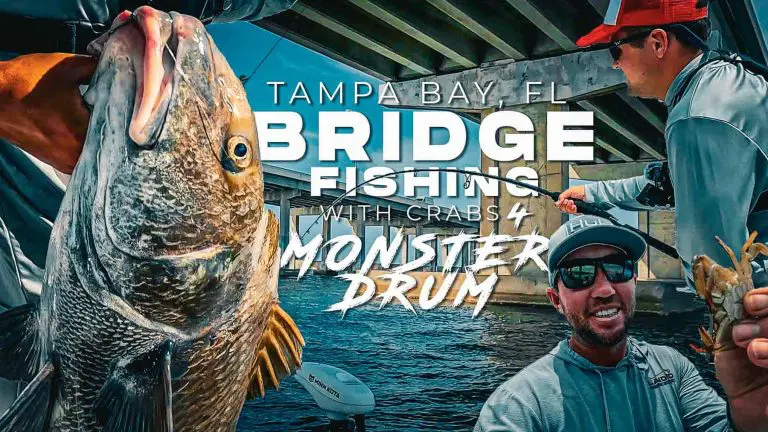
Tampa Bridge Fishing using Crab for Monster Fish Join the crew with Hog Squad Fishing and Tsunami Tackle as…
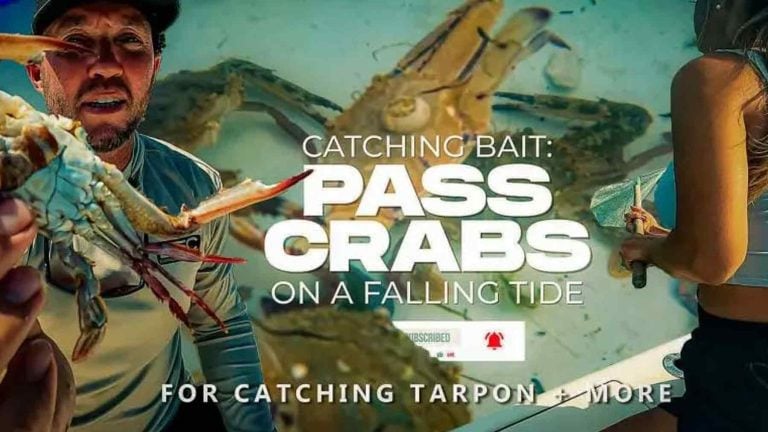
Catching Pass Crabs for Tarpon Season Welcome to another thrilling adventure with Captain Randall and his crew, where we're…


